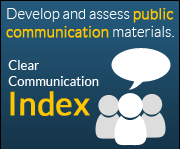The Health Literacy Initiative (HLI) provides today's healthcare insights leaders the tools and understanding required to address the growing needs of patients with a variety of health literacy levels. By providing these resources, the HLI's Clear Health Communications Task Force works to drive change within our industry and at the FDA that will equip patients to better understand their treatments, control their own health decisions and improve outcomes.
Background on Health Literacy Issues:
As healthcare becomes more patient-centric, there is an increasing need to ensure that all patients are able to obtain, process and understand basic materials to make informed decisions about their health. Did you know that only 12% of adults in the United States have proficient health literacy?1 The lower the health literacy, the more likely a person is to report they have poor health and forgo health insurance. For this reason, low health literacy has been linked to poor health outcomes – more hospitalizations, less compliance with medications and less frequent use of preventative services.2 The responsibility for improving health literacy falls upon industry professionals and the HLI seeks to do just this.
Where to Start:
AMA-AAMC's Advancing Health Equity: Health Equity Guide to Language, Narrative and Concepts, October 2021
Intellus Health Literacy Article, published in Quirks, Sept 2017 - The purpose of this article is to raise awareness of how health literacy could be used as a lever to improve public health, while challenging market researchers to consider health literacy as both a responsibility and an opportunity in their research designs.
Patient-Centric Communications - HLI-fielded study on how pharma, market research, and other organizations are implementing practices to make materials more easily understood.

Don’t Assume. Assess! Your organization should stay current on health literacy concerns. Visit the CDC's webpage to learn how to conduct health literacy assessments in your organization.

CDC's Clear Communication Index, a research-based tool that helps you develop and assess communication materials for your intended audience.
CDC information and tools to improve health literacy and public health.
Health Literacy Principles Checklist - Ensure that materials are plain, simple and understood by following as many principles as possible!
Kara Jacobson and Ruth Parker, participants of the Institute of Medicine's Roundtable on Health Literacy, capture 20 years of work in the health literacy arena in a brief discussion paper: “Health Literacy Principles: Guidance for Making Information Understandable, Useful, and Navigable.”
 - AHRQ's tools for assessing health literacy
- AHRQ's tools for assessing health literacy
“Back to School: Patient Education” published by Georgetown University: This resource discusses how front-line clinicians often serve as patients' teachers, facing the same challenges and accomplishments as teachers in the classroom. Within the article, there is a helpful infographic that provides teaching strategies for clinicians, including motivating, planning lessons, assigning homework, testing knowledge, and celebrating success. It emphasizes the role that front-line clinicians play in improving health literacy with their patients.
HLRP: Health Literacy Research and Practice - perspective piece on health literacy in market research, and it contains some validation testing resources.
1 U.S. Department of Health and Human Services Office of Disease Prevention and Health Promotion. Quick Guide to Health Literacy: Health Literacy Basics. Available at http://www.health.gov/communication/literacy/quickguide/factsbasic.htm . Accessed February 24, 2015.
2 U.S. Department of Health and Human Services Office of Disease Prevention and Health Promotion. Quick Guide to Health Literacy: Health Literacy and Health Outcomes. Available at http://www.health.gov/communication/literacy/ quickguide/factsliteracy.htm. Accessed February 24, 2015.